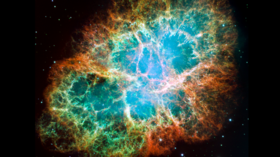Two stars merging created iconic blue SUPERGIANT supernova in a galaxy next door

Two stars in a galaxy next door to ours came together to create an epic space event by merging into a supergiant star that subsequently provoked an enormous, catastrophic supernova, exciting new research has indicated.
Scientists at Japan’s prestigious RIKEN research institute appear to have finally solved the mystery of an epic star explosion that has puzzled boffins since it was witnessed by astronomers in 1987.
Also on rt.com Spaceship could surf supernovas across universe at nearly LIGHT-SPEED, Harvard study proposesThe supernova, dubbed SN 1987A, took place in the Large Magellanic Cloud, one of our galaxy's closest neighbors. Experts have spent more than 30 years scrutinizing the aftermath of the violent destruction in a bid to understand the star and the cause of its doom.
Simulations by RIKEN astrophysicists suggest that the supernova originated from an explosion of a blue supergiant formed by the merger of two stars.
This type of supernova occurs when the core of a massive star can no longer withstand its own gravity. It collapses in on itself and unleashes an enormous explosion that obliterates the star's outer layers and leaves a neutron star or black hole in its wake.
These types of supernova are usually caused by red supergiants, which are even larger than their absolutely massive, blue counterparts. However, simulations by the RIKEN scientists prove that it ticks all the boxes.
Also on rt.com One of the brightest explosions ever seen was actually a giant star EATING its neighbor – studyThe simulation found that during the epic merger, the larger star would have violently stripped matter from its smaller companion, sending it spiraling inward until it was completely absorbed to form a rapidly rotating blue supergiant.
In a study published in the Astrophysical Journal the scientists even suggested where astronomers should look to find the neutron star that was left behind after the extraordinary explosion.
Like this story? Share it with a friend!














